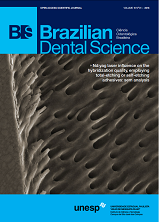Antimicrobial activity of calcium hydroxide associated with a new vehicle (Triethanolamine)
DOI:
https://doi.org/10.14295/bds.2016.v19i1.1179Resumo
Objective: The aim of this study was to evaluate the antimicrobial effectiveness of calcium hydroxide associated with a two conventional (anesthetic liquid and olive oil) and a new vehicle (Triethanolamine). Material and methods: Initially, microorganisms were collected from four upper incisors presenting unsatisfactory root canal treatments and persistent apical periodontitis from the same patient using sterile absorbent paper cones placed inside the root canal following initial access and root filling removal. Next, they were grown in a BHI culture medium for 24 h. Afterwards, they were placed in 10 Petri dishes with 3 holes, where different formulations of the medications studied were placed. After 48 and 72 h, readings were taken of the growth inhibition halos. Results: After using Kruskal-Wallis test with significance level of 1% (? = 0.01) it was observed that, calcium hydroxide associated with Triethanolamine, produced results similar to those produced by the anesthetic liquid. Both combinations were superior to the association with olive oil. Conclusion: Considering the results of this in vitro study, it is possible to consider that Triethanolamine can be a viable alternative to be used as a vehicle associated with the calcium hydroxide.
Keywords: Vehicles; Calcium hydroxide; Endodontics.
Downloads
Downloads
Arquivos adicionais
Publicado
Como Citar
Edição
Seção
Licença
TRANSFERÊNCIA DE DIREITOS AUTORAIS E DECLARAÇÃO DE RESPONSABILIDADE
Toda a propriedade de direitos autorais do artigo "____________________________________________________________________" é transferido do autor(es) para a CIÊNCIA ODONTOLÓGICA BRASILEIRA, no caso do trabalho ser publicado. O artigo não foi publicado em outro lugar e não foi submetido simultaneamente para publicação em outra revista.
Vimos por meio deste, atestar que trabalho é original e não apresenta dados manipulados, fraude ou plágio. Fizemos contribuição científica significativa para o estudo e estamos cientes dos dados apresentados e de acordo com a versão final do artigo. Assumimos total responsabilidade pelos aspectos éticos do estudo.
Este texto deve ser impresso e assinado por todos os autores. A versão digitalizada deverá ser apresentada como arquivo suplementar durante o processo de submissão.




























